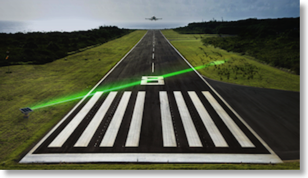Home
A comprehensive resource for safe and responsible laser use
UK: Animal lovers protest using lasers to scare away geese
The manager of Hall Place, the Bexley council, introduced the laser to reduce the number of geese.
According to a May 17 2019 news story, "The geese are said not to be hurt by the laser and perceive the approaching beam as a physical danger or predator-like presence and so disperse."
But members of the public and the Royal Society for the Prevention of Cruelty to Animals raised concerns. Some of these were about the safety of aiming laser light towards the animals. An RSPCA spokeswoman said: “As with humans, we would not support shining a laser directly into an animal’s eye."
Other concerns were about forcing the geese to leave their "home." One person who started a petition said "The laser shoots out this green light that gives a shock that tells them it is not safe… If we keep pushing them away, there will be nowhere for them to go."
From the Evening Standard
US: Bird wearing tiny goggles safely flies through laser beam
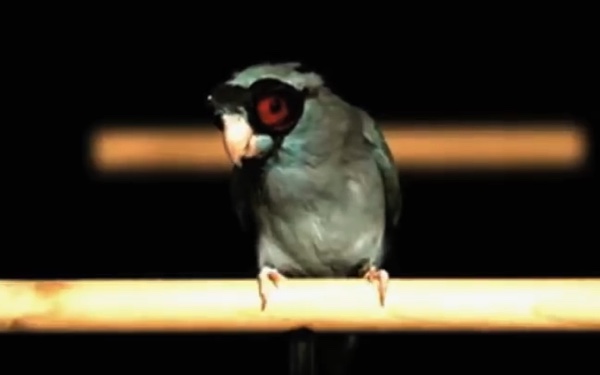
Researchers at Stanford University wanted to get data on how much lift a bird generates. To monitor the wing wake and vortices, they used a laser beam spread by a lens into a plane of light. The light source was a Litron brand double-pumped Neodymium-doped yttrium lithium fluoride (Nd:YLF) laser. The light was green at 527 nanometers, and had a pulse repetition rate of 1 kHz.
A non-toxic mist in the air illuminated the light sheet, just like theatrical fog used at concert laser light shows. As the bird flew through the light, the mist scattered and showed the air patterns, in a technique called “particle imaging velocimetry” or PIV.
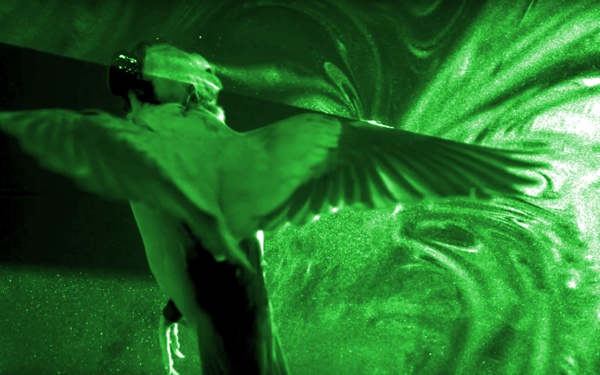
Bird-sized goggles were used to prevent any harm to the bird’s eyesight. The lenses came from human laser safety glasses and had an optical density of 6, meaning that they transmitted only 0.0001% of the laser light. The frame was 3D printed and was held on by veterinary tape. The goggles weighed 1.68 grams, which is roughly 6% of the bird’s body weight (equivalent to 9 pound glasses on a 150 lb. human).
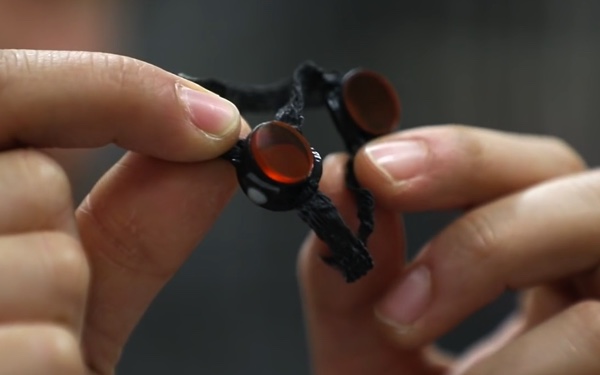
Before beginning the series of experiments, the researchers trained four parrotlets “through many small stress-free steps of habituation.” After “several months of effort” with the birds, only one — a parrotlet named “Obi” — voluntarily flew with the laser goggles. According to the researchers, “[a]ll training and experimental procedures were approved by Stanford's Administrative Panel on Laboratory Animal Care.”
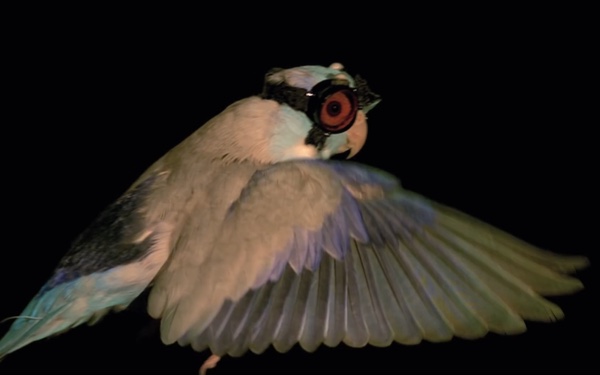
Twelve cameras were used. Four high-speed stereo cameras were for PIV particle motion recording and recorded 4000 frames per flight. Eight cameras were for recording Obi’s wing and head kinematics as it flew from one perch, through the laser light plane, to a landing perch.
The results give “the clearest picture to date of the wake left by a flying animal.” Unexpectedly, the wing tip vortices did not stay stable as happens with aircraft, but instead broke up quickly and violently. This had not been predicted by any previous models.
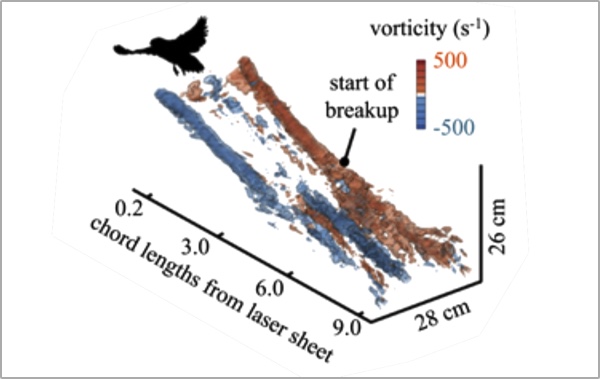
From a Stanford University news story, picked up by numerous websites and news outlets including Popular Mechanics, NBC News, The Verge, Optics.org and many others. The results were published December 6 2016 in the journal Bioinspiration & Biometrics, volume 12, number 1. Thanks to Drs. Ronald K.A.M. Mallant, MSc. for pointing out an error in our description of OD 6 density; the error has been corrected.
Canada: Students developing laser scarecrow to keep geese from crops
The group’s research found that green lasers, even at low power levels, scare geese at night when they are roosting in fields, eating the green shoots of crops such as wheat and barley. They can do “significant damage,” Rashleigh said.
There is a solution during the daytime involving noise from pyrotechnics, but this can’t be used at night in a residential area.
For nighttime geese deterrence, the students looked at other options and concluded that using lasers was the best way to solve the problem. They developed a device placed about 12-15 feet off the ground, installed in the center of the field. It moves the laser across an area, throughout the night. So far, it appears to be “fairly effective.” Response has been “quite positive” from other farmers.
Rashleigh told CBC News that “safety is a huge concern.” The laser only shines where it is intended, in the field. The beam is less powerful than most handheld laser pointers; a person would have to stare into the beams for “about 8 seconds” to have any risk of damage. To protect aircraft, the device can detect if it is being pointed above the horizon, and can shut itself off.
From CBC News, via Forbes
US: Lasers create light fence to protect birds in Hawaii
According to the Kaua’i Island Utility Cooperative, “The lasers are similar to common laser pointers and use a narrowly focused green beam of light. Because the beams are parallel to the ground and because the installation is not in designated air space, the lasers do not pose a hazard to aircraft or passersby.”

Lasers create a “light fence” to illuminate transmission poles and power lines in ‘Ele‘ele, Kaua‘i in August 2014. Kaua‘i Island Utility Cooperative is again experimenting with lasers and other devices to reduce collisions between endangered seabirds and utility equipment during the season when the seabird colonies are most active. Photo credit: Shelley Paik, Kaua‘i Island Utility Cooperative
From a press release by the Kaua’i Island Utility Cooperative (reprinted below).
Worldwide: Handheld laser being used by airports to disrupt birds
The Aerolaser is made by the Delft, Netherlands company “Bird Control Group”. The handheld device uses a green laser with a range over 2500 meters (1.6 miles). The company claims that birds do not grow used to the laser, and it is safe for the animals. According to an article at the website IHS Airport360, “As a safety feature, the laser is disabled above a certain height - this prevents the beam from being shone directly at aircraft or controllers in the tower.” In addition, the operator can look through a scope so he or she knows where the beam will be directed.
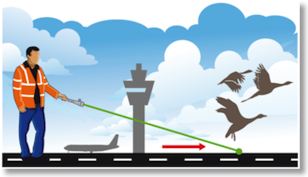
Conceptual diagram of using a handheld laser around airports, from Aerolaser.com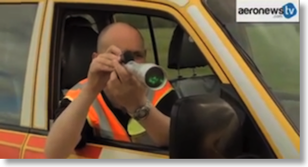
A frame from an Aerolaser video describing use at the Southampton airport.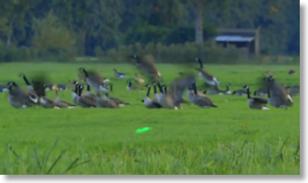
A frame from another Aerolaser video showing laser light scattering birds.
The company also makes an automatic, autonomous system called Aerolaser Groundflex, pictured below from the company’s website:
According to Wikipedia, “bird strikes are a significant threat to flight safety” since 35% of strikes result in damage to the aircraft, costing $400 million per year in the U.S. and up to $1.2 billion per year worldwide.
Bird Control Group also makes the Agrilaser Lite (range of 1000 meters) and the Agrilaser Handheld (range over 2000 meters), intended to keep birds away from fields and crops.
From Aerolaser.com, Agrilaser.com, IHS Airport360, and Wikipedia’s “Bird strike” article
Scotland: Concern over using laser pens to banish pigeons from Parliament building
Hawks were originally used to scare pigeons away from the modern building, opened in 2004. When these proved unsuccessful, contractors turned to the laser pens. They are primarily used at dawn and dusk to disturb and disperse roosting pigeons.
A spokesperson for the Pigeon Control Advisory Service said “Laser pens can be lethal and blind animals and birds. They are definitely not something we would ever recommend.” PETA, People for the Ethical Treatment of Animals, also said the animals eyes could be damaged and that other humane, non-harmful methods should be used.
From the Edinburgh News, Jan. 23 2014. Thanks to Paul Bluesky for bringing this to our attention.
UPDATED Jan. 27 2014: The contractors said they must abandon the “no kill” policy in order to further reduce the pigeon population on the Scottish Parliament building. A Parliament spokesperson said there had been no change of policy. From the Edinburgh News
